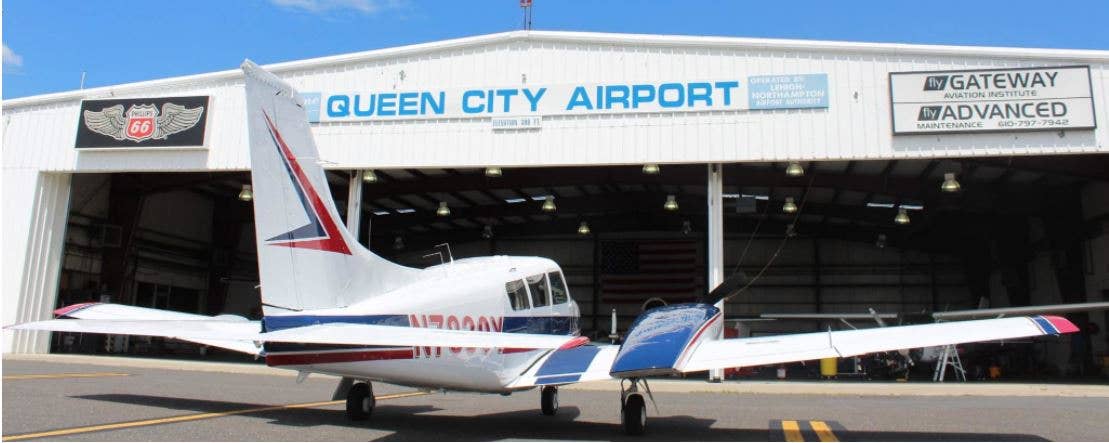These Six Airports Have Uncertain Futures
More GA airports could close as noise complaints and land values rise.

Allentown Queen City Municipal Airport in Allentown, Pennsylvania. [Courtesy: Allentown Queen City Municipal Airport]
The U.S. is full of airports—more than 19,000 of them—when you include heliports, seaplane bases, and what the FAA calls “other landing facilities in the United States and its territories.”
But at the general aviation level, the total is closer to 3,300 for airports that are open to the public and part of the FAA’s National Plan of Integrated Airport Systems. That’s still a big number, but it is getting smaller as airports across the country close, for reasons that range from a critical mass of noise complaints to real-estate development plans that value warehouses and shopping malls above runways and ramps.
For pilots who have been around a while, airport closings can start to feel like an epidemic. We read about (and in our case, write about) political maneuvering aimed at “repurposing” airports. Communities make economic and environmental cases for cutting pollution or putting the space to what they consider better use, as with the current battles over Reid-Hillview Airport (KRHV) in San Jose, California, and Hartford-Brainard Airport (KHFD) in Hartford, Connecticut.
Personal experience also shapes our opinions. East Hanover Airport (N58) in New Jersey, where I got to briefly take the controls of a Cessna 182 while in fifth grade, closed in the 1980s, but no development followed. You can still see the runway through the weeds. About 50 miles northwest, Trinca Airport (13N), where I made my first decent tailwheel landings, closed two years ago. The sweet grass strip could no longer resist the force of rising real-estate values.
As more people move farther from cities, rural areas once considered “the middle of nowhere” and perfect for airfields are suddenly ripe for development. Meanwhile urban neighborhoods, some of them on the rise after years of decline, seek to keep existing residents while attracting new ones. An airport’s expanse, with space for new homes, stores, offices, and parks, must make a tempting target.
Below are six airports whose futures are in doubt for a variety of reasons. Some of their stories are well-known, some not. But in each case pilots, flight students, mechanics, FBO operators, and others in the aviation business will miss them if they close.
Allentown Queen City Municipal Airport (KXLL), Allentown, Pennsylvania
Opened in 1943 as part of a production site for Consolidated-Vultee military aircraft for World War II, the airport has been considered for other uses throughout its history. The city of Allentown and other groups have proposed building high-rise apartments and a warehouse on the property and using the runways as drag strips, only to be thwarted by resistance from the local community and federal officials.
Teterboro Airport (KTEB), Teterboro, New Jersey
While many airports face threats of closing within months or a few years, the end of the line for Teterboro, a hub for business aviation, could be decades away. Still, the outlook is grim, according to the Regional Plan Association, a nonprofit that seeks to improve economic and environmental conditions. The group says Teterboro, with a field elevation of 8.4 feet, is likely to be flooded most of the time by late this century.
Robert Newlon Field (I41), Huntington, West Virginia
Known for its Fly In Cafe, outdoor activities and RV campsite, this 2,300-foot turf strip is friendly to vintage taildraggers. Attractions include a Fly-In Festival in August, the nearby Cabell County Fairgrounds and October’s Milton Pumpkin Festival. The airport’s fans worry that disputes between the county commission, which owns the property, and the airport manager could result in the sale and possible closure of the airport.
Santa Monica Municipal Airport (KSMO), Santa Monica, California
Many have heard about the years-long dispute over this legendary airfield that was once home to Douglas Aircraft Company. It is a classic case of residential zones closing in around a once-remote airport. Complaints about noise and pollution eventually resulted in the shortening of the runway to 3,500 feet from 5,000 feet in 2017 to keep jets out. That year local and federal officials also agreed to close the airport on December 28, 2028. But airport advocates continue efforts to save it.
Whiteman Airport (KWHP), Pacoima, California
The Los Angeles County Board of Supervisors began looking into options that include possible closure following a handful of accidents near the airport, which is in a densely built-up area. In January, an airplane set down on nearby railroad tracks and was hit by a train shortly afterward. Police video showed officers pulling the injured pilot free of the wreckage seconds before the train destroyed the aircraft.
Coleman A. Young Municipal Airport (KDET), Detroit, Michigan
A model for other big-city airports when it opened in 1927, the facility was Detroit’s primary airport until 1947, when many airlines moved to Willow Run Airport (KYIP) and later to Detroit Metro Airport (KDTW). From the mid-1960s through the 1990s, several airlines returned, but the airport gradually became better-known for dilapidation. While the city has looked into redeveloping the site for other uses, private groups have sought to raise funds, revamp the airport and keep it open. While its GA operations continue, its future remains uncertain.

Sign-up for newsletters & special offers!
Get the latest FLYING stories & special offers delivered directly to your inbox






